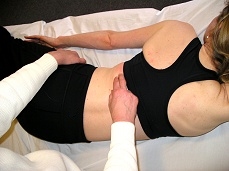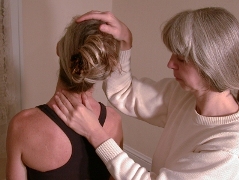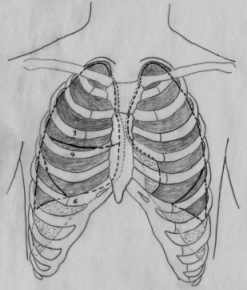New Directions in Manual Therapy
The Manual Therapy Series
Course Contents
- General Osteopathy: History. Still's principles.
- Functional unity of body. Function and structure.
- Somatic lesion. Hierarchy of restrictions.
- Whole body evaluation and treatment.
- Barrier concept and types. Matching treatment to barrier. Non-physical barriers.
- Circulation and reflex modification. Reflexive segmental facilitation. Neurophysiology of dysfunction.
- Osteopathic techniques; Direct / indirect.
- Normal spinal biomechanics. Type I, II and III motion.
- Dysfunctional spinal mechanics. Type II flexion and extension restrictions. Type I neutral group restrictions.
- Palpation exercises. Palpation skills for regional screening and segmental treatment, individually facilitated.
- Painful protective tissue spasm. Effects of joint dysfunction. Myofascial density determinants.
- Principles of effective Muscle Energy, Positional Release and Fascial Release Techniques.
- LAB sessions - Evaluation and Treatment:
- The content of these courses is primarily practical and "hands on."
Please Note:
These courses provide 20 Continuing Education contact hours for Oregon therapists.
A complete course manual will be provided.
Manual Therapy for the Lumbar Spine
An Osteopathic Approach
The Lumbar Spine is the well known site of that "low back pain" complaint. And although a great deal of medical advice is geared toward skeletal and disc pathologies, the majority of such complaints develop through joint dysfunction and soft tissue strain and may be resolved with manual therapy.
This course will demonstrate the biomechanical and neurological relationships and priorities of the lumbar spine with the areas above and below, diagnostic guidelines to make sense out of systematic palpatory evaluation, and treatment sequences interweaving various therapies according to those palpation findings.
Various motion / tissue qualities will be taught. A palpation continuum for each of spinal motion, tissue tension, tissue density and resiliency will be presented.

The components of a sedentary, "flexed body" lifestyle will be explained, with emphasis on the shortened, hypertonic iliopsoas flexors and the conversely rigid stabilizing extensors of the spine. This postural dynamic can compound the severity of any subsequent traumatic injury or overuse strain.
A specialized Psoas Protocol will be shown to treat latent painful spasm, hypertonicity, Trigger Points and adhesions in that significant and central lumbar muscle.Balance in this core musculature is often overlooked or ineffectively treated. This provides a quick yet relatively painless route to normal psoas length and function.
Simple to perform exercises to support and progress the manual therapy will be demonstrated.
Common conditions will be addressed:
- Low back pain
- Acute lumbar strain
- Loss of motion / stiffness
- Disc protrusion, stenosis
- Scoliosis
Course Dates:
| Friday | Sept. 26, 2014 | 9 am - 5:30 pm |
| Saturday | Sept. 27, 2014 | 9 am - 5:30 pm |
| Sunday | Sept. 28, 2014 | 9 am - 3:00 pm |
| Cost: | $450- | Postmarked by Sept. 1. |
| 495 - | Normal Tuiton, including course manual. | |
| 395 - | Facility "3 or more" discount | |
| 350 - | Student discount. |
Registration
Please download or contact us for a registration bruchure.
Location
- Wellspring School
- 2440 NE Marting Luther King Blvd.
- Portland, Oregon 97212
| ================== | ================= | ================== |
M E T: Cervical Spine
With Adjunct Manual Therapy Modalities
The Cervical Spine is often the primary area of complaint heard today. Yet treating that "pain in the neck" directly may either bring only temporary relief at best or even exacerbate symptoms. Since the peripheral and autonomic enervation for the entire body as well as all circulatory vessels to and from the CNS traverse the neck, compressive stesses here can have quite wide-ranging negative effects.

This course will demonstrate the biomechanical and neurological relationships and priorities of the cervical spine with the areas above and below, diagnostics to make sense out of a systematic palpatory evaluation, and suggested treatment sequences interweaving various therapies with emphasis on the muscle energy technique.
Consideration will be given to the effects of the sedentary, "flexed body" lifestyle habits so often present in patients today. This can compound the severity of subsequent traumatic or overuse injury. Simple exercises to counteract this posture and support the manual therapy will be demonstrated.
Common conditions will be addressed:
- Headache
- Whiplash
- Loss of motion / stiffness
- Disc protrusion
- Upper extremity / shoulder symptoms
Course Dates: TBA
| ================== | ================= | ================== |
M E T: The Thorax
With Adjunct Manual Therapy Modalities
THE THORAX, considering that it contains the circulatory system of the lungs and heart upon which life depends, remains largely undertreated in manual therapy. The fact that the body’s greatest loss of mobility is more often than not located in the thorax, demanding compensatory hypermobility in joints elsewhere to keep the body functioning, is simply overlooked. And immobility within the ribcage is especially problematic, activating sympathetic nervous distress and referring pain to widespread and unexpected areas. Thoracic mobilization is most often the

Within this cavity originate sympathetic nerves which influence the whole digestive and eliminative process, inhibit hormone and enzyme secretion, and even enervate the organs of procreation. Spinal nerves enervate the heart, lungs and the ribs that must move in order to accommodate their expansion-contraction rhythms. Thus restriction and compression here have widespread detrimental effects, especially sympathetic overstimulation.
And musculoskeletal articulations here are by far the most numerous of any region of the body, presenting complex restrictions that challenge the therapist to sort it all out:
- Why would I waste my time in the thorax; the patient has a low back, cervical, shoulder, sacroiliac problem?
- Isn’t that normal, everybody is a little tighter there?
- I’m trying to treat a headache!
- Where to begin and end in the thoracic?
This course will demonstrate the biomechanical and neurological relationships and priorities of the thoracic spine and ribcage with adjacent areas, diagnostics to make sense out of a systematic palpatory evaluation, and suggested treatment sequences interweaving various therapies with emphasis on the muscle energy technique.